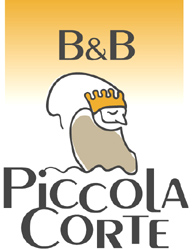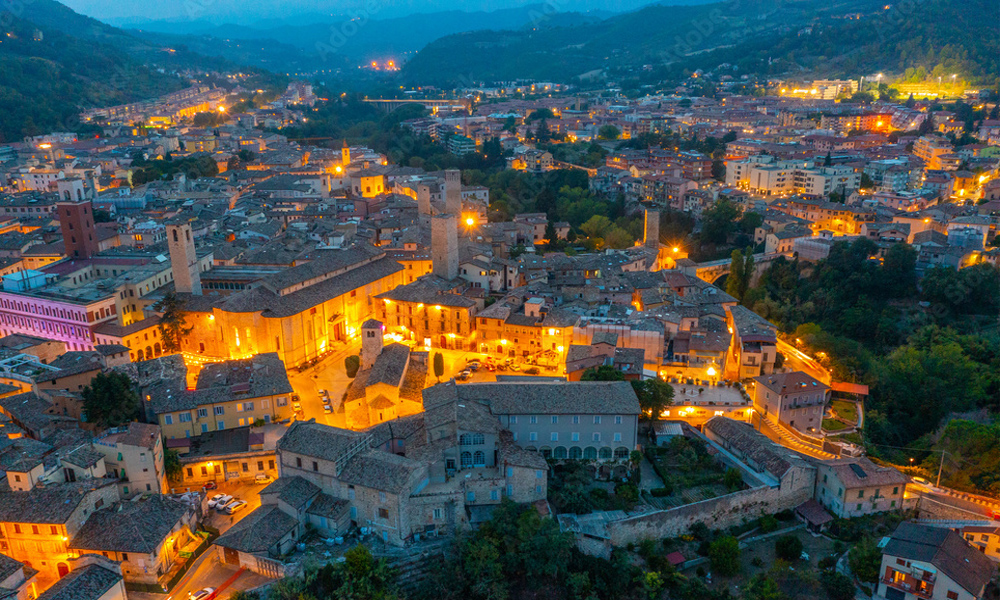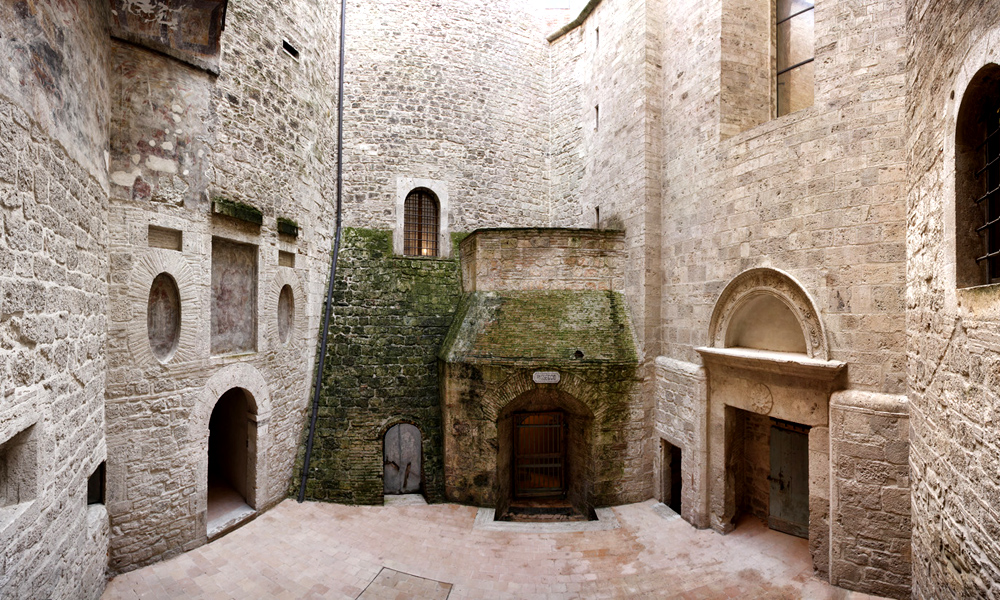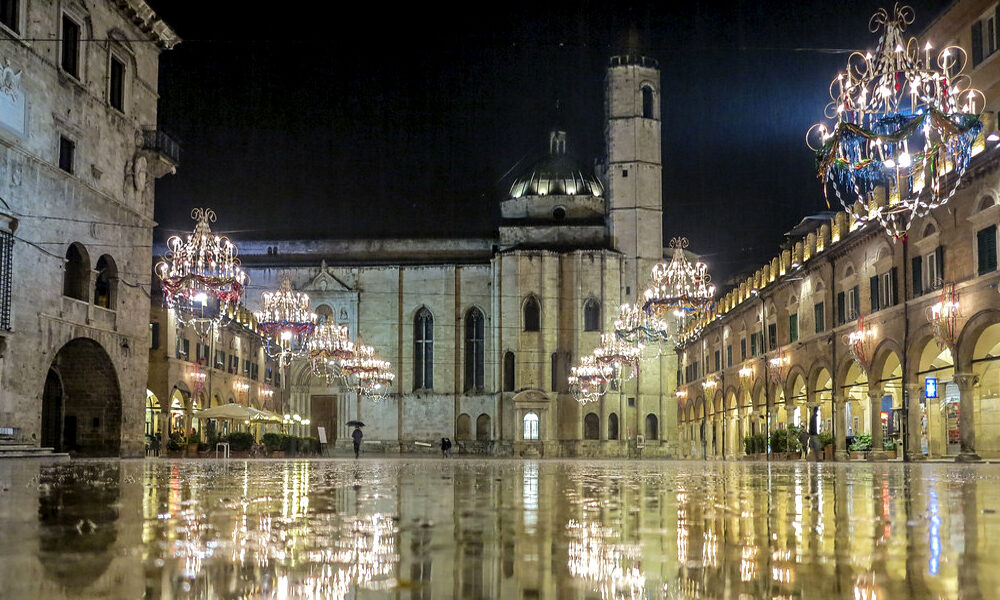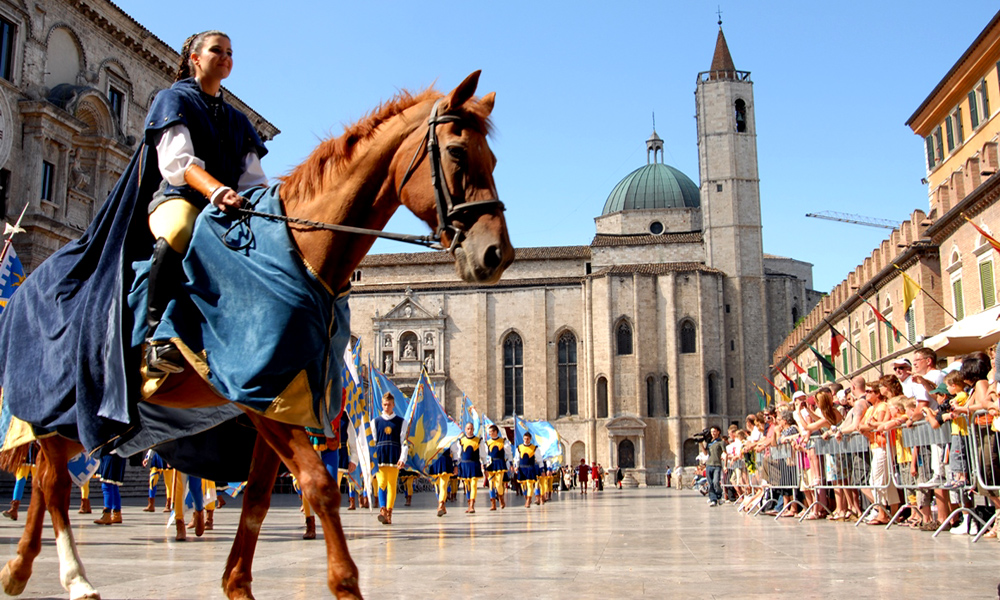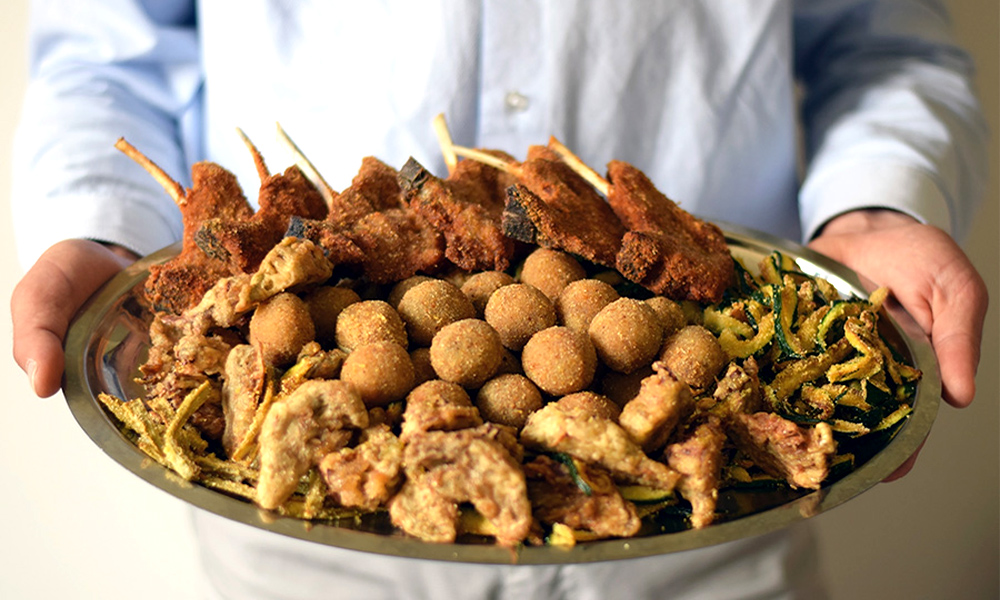Curiosità, storia e gourmet – Curiosity, history and gourmet
Travertino, Quintana, ceramica, 100 torri, Calanchi, Dito del Diavolo, Anisetta Meletti, Oliva all’Ascolana, Falerio e Rosso Piceno Superiore: sintetizziamo così la bellissima città di Ascoli Piceno, un gioiello della regione Marche e dell’Italia. Oggi vi indichiamo le 10 cose imperdibili di questo capoluogo, che offre tanto da vedere, da scoprire, da fare e da assaggiare.
Travertine, Quintana, ceramic, 100 towers, Calanchi, Dito del Diavolo, Anisetta Meletti, Oliva all’Ascolana, Falerio and Rosso Piceno Superiore: this is how we summarize the beautiful city of Ascoli Piceno, a jewel of the Marche region and of Italy. Today we show you the 10 unmissable things about this capital, which offers so much to see, discover, do and taste.
La città delle 100 torri
Disseminate un po’ ovunque, la città di Ascoli Piceno, sorta quasi 2.500 anni fa in epoca pre-romana è conosciuta come la città delle cento torri, per le innumerevoli torri (in effetti quasi 200, ma oltre la metà fu abbattuta da Federico II nel XIII secolo) , gentilizie o campanarie, sorte nel trascorrere dei tempi. La più famosa è la Torre degli Ercolani o del Palazzetto Longobardo, ma seguendo lo specifico “itinerario di via delle torri”, sarà possibile ammirare anche le Torri gemelle, per poi sfociare in piazza Ventidio Basso. Molte di queste torri, nel corso degli anni, sono state ridimensionate ed inglobate nelle abitazioni o trasformate in campanili di chiese. Ricordatevi che le vie, ad Ascoli, sono soprannominate “rue”!
The city of 100 towers
Scattered almost everywhere, the city of Ascoli Piceno, built almost 2,500 years ago in pre-Roman times, is known as the city of a hundred towers, for the countless towers (in fact almost 200, but over half were demolished by Frederick II in the 13th century), noble or bell towers, which arose over time. The most famous is the Torre degli Ercolani or the Palazzetto Longobardo, but following the specific “via delle torri” itinerary, it will also be possible to admire the twin towers, and then leading to Piazza Ventidio Basso. Many of these towers, over the years, have been downsized and incorporated into homes or transformed into church bell towers. Remember that the streets in Ascoli are nicknamed “rue”!
La città del travertino… parlante
Ascoli è edificata sul travertino, ovvero un particolare marmo che si trova nel territorio e che offre scenari davvero unici. Piazza del Popolo è considerata una della più belle d’Italia, e non è possibile andare ad Ascoli senza ammirarla. In stile rinascimentale, è letteralmente incorniciata da un loggiato con 59 archi e palazzetti rinascimentali con portici e merlature. Tutta la pavimentazione è in lastre di travertino che, dopo la pioggia, assumono un suggestivo effetto a specchio. E il travertino, ad Ascoli, dal periodo umanistico è diventato parlante, grazie all’incisione sugli architravi delle porte dei palazzi di frasi, motti e proverbi, colti o dettati dalla saggezza popolare, religiosi o irriverenti, in latino e in volgare. Oggi se ne possono leggere oltre cento, in una sorta di vero e proprio testo che si può leggere lungo le ‘rue’ del centro storico.
The city of travertine… speaking
Ascoli is built on travertine, a particular marble found in the area and which offers truly unique scenarios. Piazza del Popolo is considered one of the most beautiful in Italy, and it is not possible to go to Ascoli without admiring it. In Renaissance style, it is literally framed by a loggia with 59 arches and Renaissance buildings with porticoes and battlements. The entire flooring is in travertine slabs which, after the rain, take on a suggestive mirror effect. And the travertine, in Ascoli, has become speaking since the humanistic period, thanks to the engraving on the architraves of the doors of the buildings of phrases, mottos and proverbs, caught or dictated by popular wisdom, religious or irreverent, in Latin and in the vernacular. Today over one hundred can be read, in a sort of real text that can be read along the ‘rue’ of the historic center.
Armonia e magia in Piazza del Popolo
Su questo straordinario specchio della città o salotto che dir si voglia si potrebbe scrivere pagine e pagine. La sintesi che qui riportiamo ricorda solamente la straordinaria armonia architettonica di questa piazza rettangolare, tutta di travertino, sovrastata dalla maestosa facciata del Palazzo dei Capitani del Popolo (all’interno la Sala degli Stemmi, un vero e proprio scrigno), le mura della chiesa di San Francesco, i palazzi rinascimentali, i portici e le logge. La piazza assunse la configurazione architettonica attuale nei primi anni del XVI secolo: ultimata la costruzione del colonnato nel 1509, si dette la possibilità ai privati di costruire e sopraelevare i fabbricati seguendo rigorosamente alcune regole, come l’elevazione di un solo piano oltre il colonnato e l’utilizzo degli stessi materiali edili (travertino per le finestre e mattoni rossicci per le volte e le case).
Harmony and magic in del Popolo Square
Pages and pages could be written on this extraordinary mirror of the city or living room, if you prefer. The summary we report here only recalls the extraordinary architectural harmony of this rectangular square, entirely made of travertine, dominated by the majestic façade of the Palazzo dei Capitani del Popolo (inside the Hall of Coats of Arms, a real treasure chest), the walls of the church of San Francesco, the Renaissance palaces, the porticoes and the loggias. The square took on its current architectural configuration in the early 16th century: once the construction of the colonnade was completed in 1509, private individuals were given the opportunity to build and raise the buildings by strictly following certain rules, such as the elevation of a single floor beyond the colonnade and the use of the same building materials (travertine for the windows and reddish bricks for the vaults and houses).
Oliva all’ascolana, fritto misto e Frustingo
Dire Ascoli significa dire oliva! Il prodotto principale della gastronomia ascolana è difatti la rinomata oliva “tenera ascolana”, famosa già in epoca romana. Ripiena di carne e fritta, costituisce l’elemento principale del “fritto misto all’ascolana”. La preparazione è lunga e laboriosa, perché bisogna scegliere l’oliva polposa, tenera, non amara e grande, saperla snocciolare ad elica con lo spelucchino, uno specifico coltellino usato in cucina, e poi ricomporla con il ripieno (fatto di maiale, pollo, manzo, vino, uova, parmigiano e olio). In seguito uova, impanatura e frittura. Tutti gli ascolani la sanno fare, ma a causa del lungo processo di lavorazione solitamente si scelgono le festività per prepararne in grandi quantitativi, da conservare ed utilizzare all’occorrenza. Le olive sono parte principare del “fritto misto“, con costolette di agnello, carciofi e crema pasticcera fritta che si può mangiare come antipasto o secondo, magari accompagnandolo con il vino rosso Piceno Superiore, oppure il Falerio dei Colli Ascolani, prima di terminare con un dolce tipico delle Marche, il Frustingo, a base di frutta secca e fichi. Una magia per il palato!
Ascolana-style olive, mixed fried food and Frustingo
Saying Ascoli means saying olive! The main product of the Ascoli gastronomy is in fact the renowned “tenera Ascoli” olive, already famous in Roman times. Stuffed with meat and fried, it is the main element of the “Ascoli mixed fry”. The preparation is long and laborious, because you have to choose the pulpy, tender, non-bitter and large olive, know how to pit it like a helix with a paring knife, a specific knife used in the kitchen, and then reassemble it with the filling (made of pork, chicken, beef, wine, eggs, parmesan and oil). Then eggs, breading and frying. All the people of Ascoli know how to make it, but due to the long manufacturing process, holidays are usually chosen to prepare it in large quantities, to be preserved and used when necessary. Olives are the main part of the “fritto misto”, with lamb chops, artichokes and fried custard which can be eaten as an appetizer or second course, perhaps accompanied with Piceno Superiore red wine, or Falerio dei Colli Ascolani, before finishing with a typical dessert from the Marche, Frustingo, based on dried fruit and figs. Magic for the palate!
